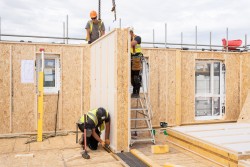Simon Horn, Stewart Milne Timber Systems Technical Development Manager, discusses the benefits of timber frame to the construction industry as a versatile, green building material and how they can reduce the greenhouse effect.
Timber frame construction offers considerable benefits regarding new housing stock being built quickly, at volume, meeting green targets and delivering significant cost savings. Not only is it beneficial to housebuilders but building in timber contributes to the UK's commitment to combat climate change while improving heat retention and reducing carbon emissions within new homes.
Europe's 400 billion trees currently absorb almost 9% of the continent's greenhouse gas emissions and, in turn, use of timber in a building will store the carbon for the lifecycle of that building.
Timber frames draw in carbon from the atmosphere and stores it, with the largest potential for this achieved in external walls, intermediate floors, and roof structures. In fact, on average, replacing just one cubic metre of concrete with timber in construction can save a tonne of carbon emissions. The embodies energy in timber is the lowest of almost all common building materials.
Lifecycle studies of timber frame homes show they significantly outperform alternatives – timber saves about 40% of carbon emissions in comparison to concrete and about 30% compared to steel. According to the Committee on Climate Change: "Using wood in construction to displace high-carbon materials such as cement and steel is one of the most effective ways to use limited biomass resources to mitigate climate change." It's important that we identify methods by which to achieve government targets and uplift the new green economy – timber frame construction must be considered a leading example.









